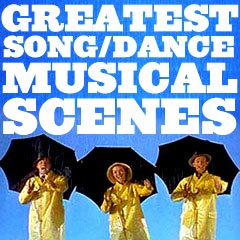
|
Musical Moments and Scenes G - 2 |
| G (continued) | ||||||||||||||||||||
| Movie Title/Year and Scene Descriptions | ||||||||||||||||||||
Gold Diggers of Broadway
(1929) One of the earliest, most successful, and most ambitious Warners' musicals using the Vitaphone process, this two-toned Technicolor film (touted as a "talking and singing natural color picture") was the first of the talkie "Gold Digger" films (although it was a remake of the silent film Gold Diggers (1923) - based on the 1919 hit play), and the second all-color talkie. Only portions of this landmark film now exist. Some of the existing footage consists of the music of Nick Lucas (as Himself), including the first rendition of Tip-Toe Thru' the Tulips (pictured), and In a Kitchenette. Winnie Lightner sang Mechanical Man. The most elaborate production number was Painting the Clouds with Sunshine (pictured). |
 
|
|||||||||||||||||||
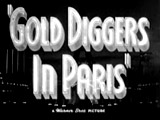
|
Gold Diggers in Paris (1938) This was the fifth and last "Gold Diggers" film, after films in 1929, 1933, 1935, and 1936. The dance productions in this Warner Brothers picture were staged by Busby Berkeley, but they were less memorable set-pieces due to slashed budgets. The musical numbers were sung by radio star and crooner Rudy Vallee (Vallee replaced Dick Powell, who turned down reprising his role, as Club Bali nightclub owner Terry Moore) who fondly impersonated Maurice Chevalier and FDR. Musical numbers included:
|
 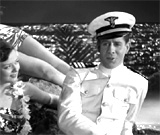 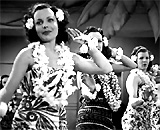  
|
||||||||||||||||||
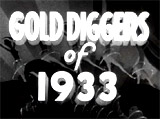
|
Gold Diggers of 1933 (1933) This was the biggest and most dazzling of the "Gold Digger" films and featured more extravagant Busby Berkeley numbers - this was the second Warner Bros. backstage musical of 1933 - the briskly-told musical directed by Mervyn LeRoy included the following numbers, with song and dance choreography by Busby Berkeley:
|
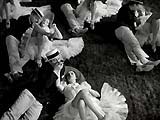  "Petting in the Park" 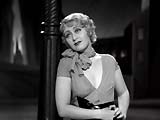 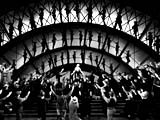 "Remember My Forgotten Man" |
||||||||||||||||||
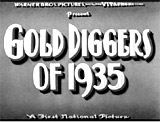
|
Gold Diggers of 1935 (1935)
This Busby Berkeley choreographed-directed film (in his debut as a solo director) featured two major production numbers (sequences somewhat detached from the surrounding plot) exemplifying his masterful trademark camerawork. This film's sole Oscar nomination and win was for Best Original Song (Lullaby of Broadway). The two major production numbers (sequences somewhat detached from the surrounding plot) in this film, from choreographer-director Busby Berkeley (in his debut as a solo director), and considered his best work, were the following:
|
 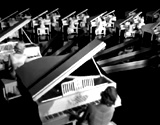  "The Words Are In My Heart"  Wini Returning Home to Walk-Up Apartment in Early AM  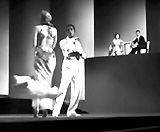  Wini with Date (Dick Powell) Back the Next Night  Acrobatic Dancing of Manny King Viewed From Below the Floor  The Final Chorus |
||||||||||||||||||

|
Gold Diggers of 1937 (1936) This was another of the expensive Warner Brothers films in the Gold Diggers series of five musicals. Busby Berkeley's closing production number All's Fair in Love and War (pictured twice), the best in the film, featured Joan Blondell leading a chorus of dozens of helmeted, drum-playing, flag-carrying females dressed in frilly white military uniforms (against a shiny black floor) as they tapped their way through a series of military formations and flag-wavings with Berkeley's trademarked geometric patterns. Another of the production numbers, Let's Put Our Heads Together (pictured), presented chorines at a summer garden party in fifty big, white rocking chairs - each with a beau. |
 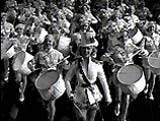 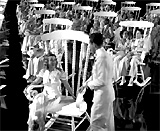 |
||||||||||||||||||
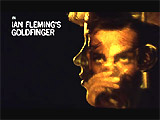
|
The third 007 film had only one winning Oscar: Best Sound Effects Editing (it was the first Bond film to be nominated (and win) an Academy Award). It was also the second Bond film to use a pop star (Shirley Bassey) to sing the theme song Goldfinger during the titles. Following the gun-barrel opening (with stuntman Bob Simmons) in this James Bond action film, there was a long pre-title credits action sequence of Bond (Sean Connery) completing a previous mission in Latin America. He caused sexy nightclub dancer Bonita (Nadja Regin) to be knocked out in her bathtub, and then electrocuted drug-smuggling thug Capungo (Alf Joint) in Bonita's bathtub with a round electrical heater fan. The stirring credit sequence title song Goldfinger (pictured) then followed, performed by Shirley Bassey, with memorable lyrics about Bond's newest villain, rich, greedy, gold-smuggling villain Auric Goldfinger (Gert Frobe):
|
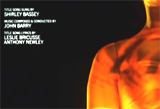
|
||||||||||||||||||
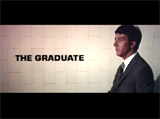
|
Mike Nichols' classic 60's generation-gap comedy was complemented by a musical soundtrack written and sung by the pop duo group of the time, Simon & Garfunkel from their Grammy-winning The Sounds of Silence album (with songs composed earlier and previously-released except for Mrs. Robinson), with meaningful, haunting lyrics amidst koo-koo-kachoo sounds, to enhance the film's moods and themes. However, unlike most soundtracks, all of the tunes only served as background music.
The opening title-credits sequence was of young, recent college graduate Benjamin Braddock (Dustin Hoffman) on a plane 'descending' into LA, returning home from college in the East. Appearing slightly shy and unprepossessing, his face had a blank, expressionless, enervated, zombie-like look. While standing mute by himself on the automated, moving walkway (with a monotonous recording: "Please hold the handrail, and stand to the right. If you wish to pass, please do so on the left") at the busy LAX airport, the credits played as The Sounds of Silence (pictured) was heard on the soundtrack, reinforcing the theme of his emptiness and alienation from his surroundings:
The scene of the retrieval of his luggage from a mechanized conveyor belt, and his disappearance into the terminal's crowd and to the outer doors dissolved into the next scene. Benjamin was in his upstairs bedroom in his upper-middle-class parents' home. He sat staring blankly ahead, positioned in his room in front of his aquarium tank (while observing its occupants) and wanting to be alone with his thoughts. Although much of the film was involved with the affair Benjamin conducted with lecherous, close family friend Mrs. Robinson (Anne Bancroft), the song Here's to You Mrs. Robinson (pictured) - with a strumming guitar - was not heard until late in the film:
It was during Benjamin's frantic search to rescue girlfriend Elaine Robinson (Katharine ) from her impending marriage in Santa Barbara (he first drove in his convertible Alfa Romeo Spider red sports car to Berkeley from LA, and then turned around to drive back down the state). |
 
|
||||||||||||||||||

|
Grease (1978)
This immensely popular screen musical directed by Randal Kleiser was the longest-running Broadway show in history by 1979. The film was highly influential as a teen flick, and led to similar films, such as Fame (1980), Footloose (1983), Flashdance (1984), and Dirty Dancing (1987) in the next decade. Many of the catchy numbers ("Grease is the word!") set in a 50s high school (with overaged students) were sung by 29 year-old John Travolta and sweet-voiced 24 year-old Australian singer Olivia-Newton John as rebellious Danny Zuko and good girl Sandy Olsson respectively, including:
The showstopping finale was You're the One That I Want (pictured) at a graduation school carnival, with Olivia Newton-John in tight, black leather pants that literally had to be sewn onto her, followed by the ensemble cast singing We Go Together (pictured), and ending with the two flying away (!) in Greased Lightning. |
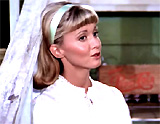  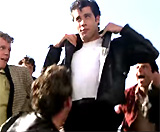 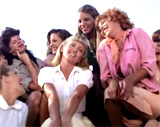 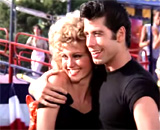 
|
||||||||||||||||||
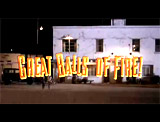
|
Great Balls of Fire! (1989) This musical biopic was highlighted by Dennis Quaid's virtuoso impersonation of controversial rocker Jerry Lee Lewis (Quaid did his own piano playing but lip-synched the lyrics), and the memorable singing of the title song Great Balls of Fire (pictured) on a blazing piano. |

|
||||||||||||||||||

|
The Great Ziegfeld (1936) This Best Picture-winning, lavish MGM episodic biopic of the showman Flo Ziegfeld (portrayed by William Powell) included elaborate, mechanical camera-work production numbers (matching Busby Berkeley's productions). Its most famous sequence included a fabulous crane shot of a slowly-spinning, cork-screwing tower of stairs holding singers, musicians, and other artists. Also, it featured the fictional and real-life portrayals of past Ziegfeld Follies greats, including Fanny Brice, Will Rogers, and Eddie Cantor. Gargantuan or massive production numbers and spectacular songs included:
|
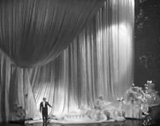 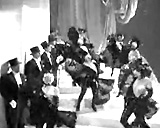 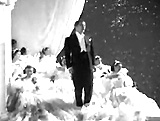 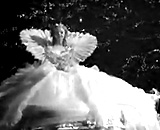 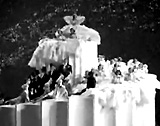 "A Pretty Girl is Like a Melody" |
||||||||||||||||||

|
A Guy Named Joe (1943) In the original MGM film (before Spielberg's remake Always (1989)), civilian cargo pilot Dorinda Durston (Irene Dunne) tenderly sang to her reckless and carefree heroic pilot lover Pete Sandidge (Spencer Tracy):
As she crooned, he lovingly gazed into her eyes, and then she danced with him, while pal Al Yackey (Ward Bond) played a harmonica. The tune served as the thematic leitmotif for the love between the two. |
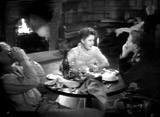  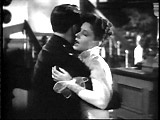
|
||||||||||||||||||
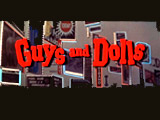
|
Guys and Dolls (1955) This Samuel Goldwyn production (directed by Joseph L. Mankiewicz), developed from a 1931 collection of stories by writer Damon Runyon, was released by MGM in the mid-50s - and adapted from the long-running 1950 musical play. It featured marvelous Michael Kidd-choreography. Gene Kelly was supposed to play the main male role, but MGM refused to loan him to Goldwyn Studios. The film's plot told of slick big-city gambler Sky Masterson (a slightly miscast Marlon Brando in his musical debut - who sang with his own voice) who made a $1,000 bet that he could successfully romance/seduce "Save a Soul" missionary Sgt. Sarah Brown (Jean Simmons). Its most well-known song-dance number was Luck Be a Lady (pictured) performed by Brando. Other well-known songs or performances included:
|
  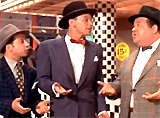   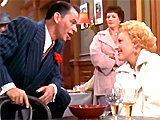 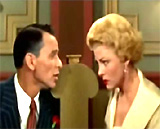
|
||||||||||||||||||
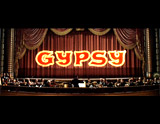
|
Gypsy (1962) This screen version of the 1959 Broadway musical play (starring Ethel Merman) by Warners -- with a Jule Styne-Stephen Sondheim score -- was suggested by the lives of the Hovick family:
The most memorable number was belted out by the Mama Rose character to Louise at a train station -- Everything's Coming Up Roses (pictured): ("You'll be swell, you'll be great, Gonna have the whole world on a plate"). Another was the wild and funny You Gotta Have A Gimmick (pictured) performed by a trio of Minsky's burlesque house strippers Electra (Roxanne Arlen), Tessie Tura (Betty Bruce) and Mazeppa (Faith Dane) to fresh-faced Louise Hovick - aka Gypsy Rose Lee on how to be a successful and innovative stripper and get applause: ("...If you wanna make it Twinkle while you shake it If you wanna grind it Wait till you refined it If you wanna bump it Bump it with a trumpet So get yourself a gimmick And you too can be a star!"). Another memorable moment was Louise's debut stage performance of Let Me Entertain You (pictured), after she was introduced as "Gypsy Rose Lee," and she made a nervous appearance on stage before an all-male audience in an elegant blue dress - and used Mama's vaudeville trademarks as Mama stood and coached off-stage and yelled tips. Gypsy teasingly removed a long white glove as she asked the audience: "Hello everybody, my name is Gypsy! What's YOURS?", and then teasingly offered: "We'll have a real good time." There was also a montage of future performances, exhibiting Gypsy's significantly improved stage show with a deeply sensual subtext, more stylish peekaboo stripping and costuming, and her trademark line to the audience: ("Hello everybody, my name is Gypsy! What's YOURS?"). The montage ended with Gypsy's introduction at Minsky's - headlined by "The Queen of Striptease" who again performed: "Let Me Entertain You" - "We'll have a real good time!" - and gave a semi strip-tease behind a curtain. |
  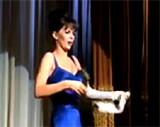 
|
||||||||||||||||||
(alphabetical by film title) Introduction | A-1 | A-2 | B-1 | B-2 | B-3 | C-1 | C-2 | D-1 | D-2 | E | F-1 | F-2 | G-1 | G-2 H-1 | H-2 | I-J | K | L-1 | L-2 | M-1 | M-2 | N-O | P-1 | P-2 | R-1 | R-2 | S-1 | S-2 | S-3 | T | U-V | W | X-Z |